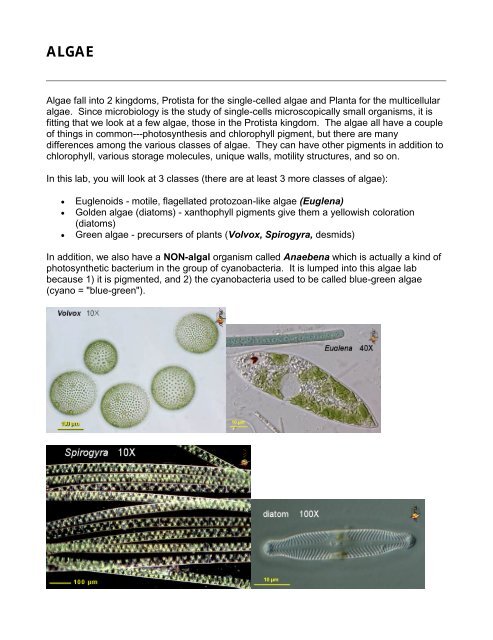Algae fall into 2 kingdoms, Protista for the single-celled algae and ...
Algae fall into 2 kingdoms, Protista for the single-celled algae and ... Algae fall into 2 kingdoms, Protista for the single-celled algae and ...
ALGAE Algae fall into 2 kingdoms, Protista for the single-celled algae and Planta for the multicellular algae. Since microbiology is the study of single-cells microscopically small organisms, it is fitting that we look at a few algae, those in the Protista kingdom. The algae all have a couple of things in common---photosynthesis and chlorophyll pigment, but there are many differences among the various classes of algae. They can have other pigments in addition to chlorophyll, various storage molecules, unique walls, motility structures, and so on. In this lab, you will look at 3 classes (there are at least 3 more classes of algae): Euglenoids - motile, flagellated protozoan-like algae (Euglena) Golden algae (diatoms) - xanthophyll pigments give them a yellowish coloration (diatoms) Green algae - precursers of plants (Volvox, Spirogyra, desmids) In addition, we also have a NON-algal organism called Anaebena which is actually a kind of photosynthetic bacterium in the group of cyanobacteria. It is lumped into this algae lab because 1) it is pigmented, and 2) the cyanobacteria used to be called blue-green algae (cyano = "blue-green").
ALGAE<br />
<strong>Algae</strong> <strong>fall</strong> <strong>into</strong> 2 <strong>kingdoms</strong>, <strong>Protista</strong> <strong>for</strong> <strong>the</strong> <strong>single</strong>-<strong>celled</strong> <strong>algae</strong> <strong>and</strong> Planta <strong>for</strong> <strong>the</strong> multicellular<br />
<strong>algae</strong>. Since microbiology is <strong>the</strong> study of <strong>single</strong>-cells microscopically small organisms, it is<br />
fitting that we look at a few <strong>algae</strong>, those in <strong>the</strong> <strong>Protista</strong> kingdom. The <strong>algae</strong> all have a couple<br />
of things in common---photosyn<strong>the</strong>sis <strong>and</strong> chlorophyll pigment, but <strong>the</strong>re are many<br />
differences among <strong>the</strong> various classes of <strong>algae</strong>. They can have o<strong>the</strong>r pigments in addition to<br />
chlorophyll, various storage molecules, unique walls, motility structures, <strong>and</strong> so on.<br />
In this lab, you will look at 3 classes (<strong>the</strong>re are at least 3 more classes of <strong>algae</strong>):<br />
<br />
<br />
<br />
Euglenoids - motile, flagellated protozoan-like <strong>algae</strong> (Euglena)<br />
Golden <strong>algae</strong> (diatoms) - xanthophyll pigments give <strong>the</strong>m a yellowish coloration<br />
(diatoms)<br />
Green <strong>algae</strong> - precursers of plants (Volvox, Spirogyra, desmids)<br />
In addition, we also have a NON-algal organism called Anaebena which is actually a kind of<br />
photosyn<strong>the</strong>tic bacterium in <strong>the</strong> group of cyanobacteria. It is lumped <strong>into</strong> this <strong>algae</strong> lab<br />
because 1) it is pigmented, <strong>and</strong> 2) <strong>the</strong> cyanobacteria used to be called blue-green <strong>algae</strong><br />
(cyano = "blue-green").
Anabaena (cyanobacteria)<br />
Great Resources!<br />
Virtual Pond Dip<br />
http://microscopy-uk.org.uk/ponddip/<br />
<strong>Algae</strong><br />
http://scitec.uwichill.edu.bb/bcs/bl14apl/<strong>algae</strong>1.htm<br />
OBJECTIVES:<br />
Recognize major groups of <strong>the</strong> <strong>algae</strong>.<br />
Identify some common species of <strong>algae</strong>.<br />
MATERIALS NEEDED:<br />
pond water<br />
cover slips<br />
prepared slides or fresh specimens of:<br />
Volvox Euglena Anabaena<br />
Spirogyra<br />
diatoms of various species<br />
THE PROCEDURE:<br />
1. Make wet mounts of <strong>the</strong> various species of <strong>algae</strong>.<br />
2. Use 10X, maybe 40X, magnification.<br />
3. Once you have found <strong>the</strong>m on brightfield, switch over to darkfield <strong>and</strong> phase-contrast.<br />
You will see much better contrast <strong>and</strong> a much more interesting organism with <strong>the</strong>se 2<br />
kinds of microscopy.<br />
4. You might want to draw <strong>the</strong>se <strong>algae</strong> since THERE ARE NO PICTURES of <strong>algae</strong> in<br />
your Photo Atlas.<br />
QUESTIONS:<br />
1. Name a criterion or feature used to categorize <strong>the</strong> <strong>algae</strong> <strong>into</strong> different groups.<br />
2. Why were <strong>the</strong> Cyanobacteria renamed from <strong>the</strong> previous name 'blue-green <strong>algae</strong>?'<br />
Fall 2011, Jackie Reynolds, Richl<strong>and</strong> College, BIOL 2421



